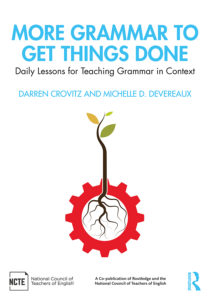Lessons for Teaching Grammar in Context
More Grammar to Get Things Done: Daily Lessons for Teaching Grammar in Context
By Darren Crovitz and Michelle D. Devereaux
(Routledge and National Council of Teachers of English, 2020 – Learn more)

More Grammar to Get Things Done is a follow-up to Grammar to Get Things Done by Darren Crovitz and Michelle D. Devereaux. The second book opens by acknowledging why teachers might have decided to read it in the first place. For most of us, teaching grammar isn’t a fun part of our jobs, so we don’t often choose to read about it.
If we’re being honest, we might not even feel competent to teach it. How can we be feeling otherwise, with such damning evidence that we aren’t teaching it effectively. Year after year, students don’t readily apply even the most basic concepts of grammar in their writing.
We know traditional drill and practice aren’t working, but the alternative, teaching grammar in context, seems overwhelming. Crovitz and Devereaux start by calling out those frustrations and inviting readers to get real about our experiences and long-held beliefs about grammar instruction.
What we can learn from art teachers

They engage students in analysis of their own and others’ art, asking them about what they notice in terms of both form and function and consider how other choices would have impacted the end result. They build on the skills their students already have as artists and encourage them to take creative risks in order to learn what works and what doesn’t.
Imagine a visual arts class where students don’t do that kind of thinking and creating, and instead, learn what seem to be arbitrary rules and then practice fixing errors on a worksheet. It’s easy to recognize the ineffectiveness of such an approach to learning in the visual arts, and yet that’s how our students are expected to learn language arts.
Teaching grammar in context, according to Crovitz and Devereaux, means that we make learning about language usage meaningful by helping students analyze pieces of writing and, through inquiry, discover tools they can use to improve their craft.
Readers are reminded that language is woven into our identity. There are some contexts that require Standard English, but there are many others in which casual usage is more appropriate. Our students come to us with varying levels of experience with dialects and usage patterns related to cultural groups. Teaching grammar in context can add relevancy to a discussion and can find a place in students’ writing. Studying language usage under those conditions can be empowering.
Protocols for teaching usage
The second half of the book offers suggested protocols for teaching 10 commonly needed usage concepts. Each concept is divided into a series of short daily lessons. At a glance, the lessons appear scripted; however the authors point out that teachers don’t need to use them that way.
They chose to provide that level of detail so that teachers who are new to this style of grammar instruction have a solid starting point. I appreciated the scripts, as they helped me visualize how the lessons might play out. Having everything laid out for me in such a way will ultimately give me the confidence to design my own.
In More Grammar to Get Things Done, Crovitz and Devereaux struck the right balance of ideological and practical to make the idea of a pedagogical shift to teaching grammar in context not only doable but exciting.
They are honest, direct, and, at times, funny. They encourage us, as teachers of grammar, to be those things too. Who knows, maybe grammar can become one of our favorite things to teach!
Karen Rubado has been working in education for over 25 years as a special education teacher, alternative education teacher and equity trainer, and in her current position as a 6th-grade reading and language arts teacher. She lives in Minnesota with her husband and dog and serves as her local union president. She enjoys camping, snowshoeing, and hanging out with her two adult children.



































Really important topic. WRITING (whether it be free expression or content driven topics) is best achieved by DOING.